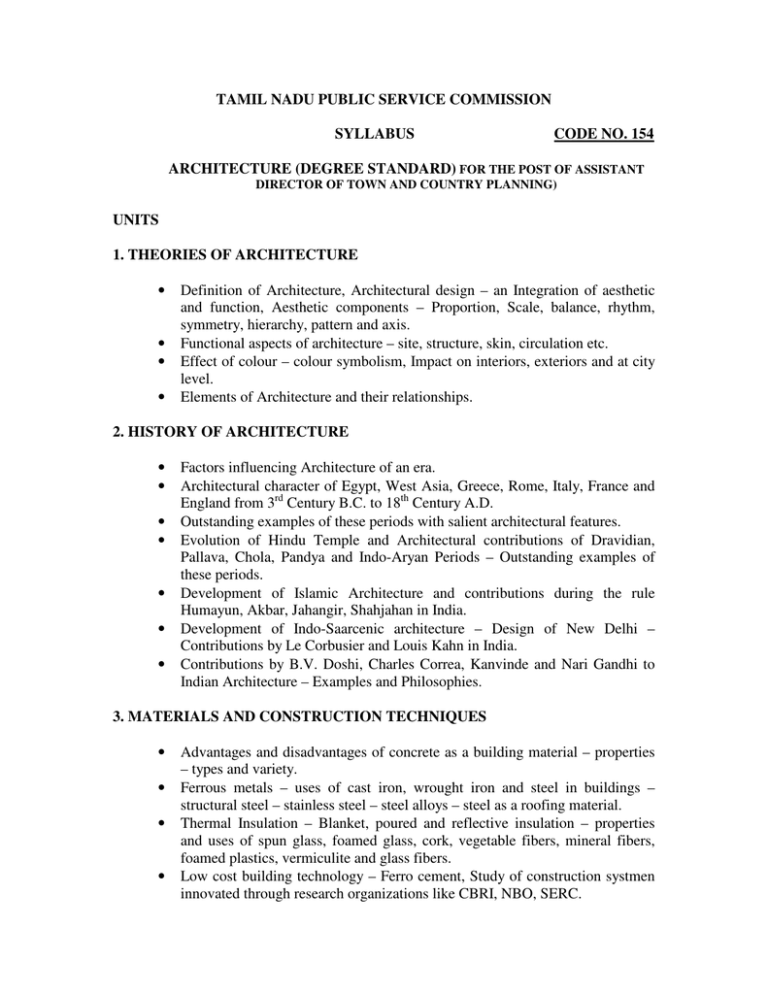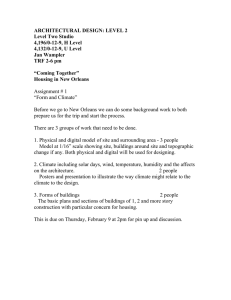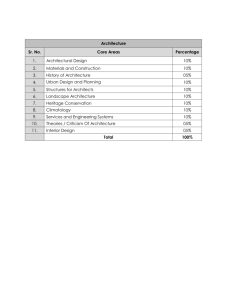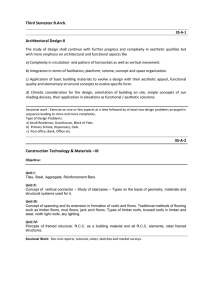TAMIL NADU PUBLIC SERVICE COMMISSION ARCHITECTURE (DEGREE STANDARD)
advertisement

TAMIL NADU PUBLIC SERVICE COMMISSION SYLLABUS CODE NO. 154 ARCHITECTURE (DEGREE STANDARD) FOR THE POST OF ASSISTANT DIRECTOR OF TOWN AND COUNTRY PLANNING) UNITS 1. THEORIES OF ARCHITECTURE • • • • Definition of Architecture, Architectural design – an Integration of aesthetic and function, Aesthetic components – Proportion, Scale, balance, rhythm, symmetry, hierarchy, pattern and axis. Functional aspects of architecture – site, structure, skin, circulation etc. Effect of colour – colour symbolism, Impact on interiors, exteriors and at city level. Elements of Architecture and their relationships. 2. HISTORY OF ARCHITECTURE • • • • • • • Factors influencing Architecture of an era. Architectural character of Egypt, West Asia, Greece, Rome, Italy, France and England from 3rd Century B.C. to 18th Century A.D. Outstanding examples of these periods with salient architectural features. Evolution of Hindu Temple and Architectural contributions of Dravidian, Pallava, Chola, Pandya and Indo-Aryan Periods – Outstanding examples of these periods. Development of Islamic Architecture and contributions during the rule Humayun, Akbar, Jahangir, Shahjahan in India. Development of Indo-Saarcenic architecture – Design of New Delhi – Contributions by Le Corbusier and Louis Kahn in India. Contributions by B.V. Doshi, Charles Correa, Kanvinde and Nari Gandhi to Indian Architecture – Examples and Philosophies. 3. MATERIALS AND CONSTRUCTION TECHNIQUES • • • • Advantages and disadvantages of concrete as a building material – properties – types and variety. Ferrous metals – uses of cast iron, wrought iron and steel in buildings – structural steel – stainless steel – steel alloys – steel as a roofing material. Thermal Insulation – Blanket, poured and reflective insulation – properties and uses of spun glass, foamed glass, cork, vegetable fibers, mineral fibers, foamed plastics, vermiculite and glass fibers. Low cost building technology – Ferro cement, Study of construction systmen innovated through research organizations like CBRI, NBO, SERC. 4. BUILDING SYSTEM AND SERVICES • • • • • • • Fundamentals of Sanitary waste and sewerage system – Basic principles of sanitation and disposal of waste matter from buildings, various sewerage disposal and their principles. Intercepting chambers, inspection chambers – their location and ventilation of sewers. Alignment of storm water drains in housing, layout and cities, collection, conveyance and disposal of town refuse. Rural Sanitation. Water distribution systems – Water distribution systems in small towns, Criteria to assess daily water requirements, Testing for water hardness, piping systems for residential and multi storied buildings. Types of pumps – Reciprocating, centrifugal, deepwell, submersible automatic pumps, sewerage pump, compressors vacuum pump. Elevators – size, capacity, speed, mechanical safety method, Types of elevators – Electric, hydraulic – passenger, hospital, capsule, freight, etc. Dumb waiters, Parallel and criss cross escalators, horizontal belt conveyors, horizontal moving walkways, physically handicapped mechanical safety systems. Electrical services – Types of wires, wiring systems and their choice, Planning electrical wiring for building, Types of earthing, Main and distribution boards. Refrigeration and Air conditioning – Window type and packaged air conditioners, chilled water plant, fan coil systems, Air conditioning systems for different types of buildings. Fire safety – Fire detection system, Fire alarm system, Fire fighting systems, Dry and wet risers, Automatic Sprinklers. 5. TRADITIONAL AND CULTURE STUDIES • • • Definition of Tradition, Meaning of Vastu and Vaastu, its classification, Relationship to earth. Traditional Site planning method – Orientation of building, site, layout and settlement, positive and negative energies, importance of cardinal and ordinal directions. The celestial grid or mandala and its types. The Vaastu Pursha Mandala and its significance in creation of patterns, and lay-outs. Types of layouts. Vernacular Architecture – Approaches and concepts to the study of Vernacular Architecture – Aesthetic, Anthropological, Architectural, Geographical, Historical, Spatial, Folkloristic. Colonial influences on the Traditional House, Goa, Bangla & Bungalow, Bengal and Victorian Villas, Settlement Planning and House Typologies in Pondicherry and Cochin. 6. URBAN STUDIES • • • • Definitions of Conservation, preservation, urban design and renewal, Need in the Indian Context. Land use structures of cities, impact of urbanization, developmental programmes and social development. Urban design concepts – Imagibility, life between buildings, transit metropolis, sustainable cities, generic cities, heritage tourism, community participation in urban design. Urban open spaces and urban landscape, street landscaping. Post Independence Urban Design in India – Influence of Chandigarh, Bhuvaneshwar and Gandhi Nagar. 7. ENVIRONMENTAL STUDIES • • • • • • Land resources – Land as a resource, land degradation, landslides, soil erosion and desertification, waste land reclamation. Landscape and ecology – Introduction to landscape architecture, ecology, ecological balance, landscape conservation, reclamation and landscaping of derelict lands. Site analysis – Importance of site analysis, on site and off site factors involved, topography, hydrology, soils, vegetation, climate, surface drainage, accessibility, infrastructure. Energy resources – growing energy needs, renewable and non-renewable energy sources, alternate energy. Urban problems related to energy. Simple passive design considerations – use of site conditions, orientation, plan form, envelope design, opening size and position to achieve solar passive architecture. Waste Management – Solid waste recycling, such as composting, vermin composting and bio gas. Liquid waste recycling, Rain water harvesting, Biological and thermal energy options. 8. URBAN AND RURAL HOUSING • • • Urban Housing – Housing and its importance in architecture. Its relationship to neighborhood and city planning. Housing need and demand – National Housing Policy – Housing Agencies and their role in housing development. Housing Design – housing typologies, integration of services, parking, sustainable practices, Qualitative aspects of housing, prefabrication in housing. Rural housing – influence of urbanization and changing life style, Uniqueness of rural housing – Mud as a building material – Soil stabilization, Bamboo, Casuarina, Coconut, Palm, Hay, - uses as building materials – fire retardant treatment, insect proofing. Building stones – types of masonry. 9. RULES, REGULATIONS AND LEGAL FRAMEWORK • • • • • • Zonal regulations – Zoning, Planned Unit Development, SEZ. Development Control rules – Significance, rules for various building types. UD PFI – guidelines, standard and regulations. National building code of India – Fire safety, ventilation, Mechanical services such as lifts and escalators. Environmental Laws in India – protection of land, forest, water and air. Coastal Landscapes – Protection, CRZ for coastal areas. 10. CURRENT TRENDS AND ISSUES • • • • • • • Technology – Computer oriented 2D and 3D drafting. Use of digital medium for designing and presentation. Use of GIS for regional planning and Urban Governance. Role of Information Technology in Environmental Protection and human health. Impact of GATT and WTO on Architecture on India. Significance of “Intellectual property rights” for architects in India. Use of ‘Right to Information’ as a powerful tool for architects. Mandatory rules to incorporate ‘Barrier free design’.





